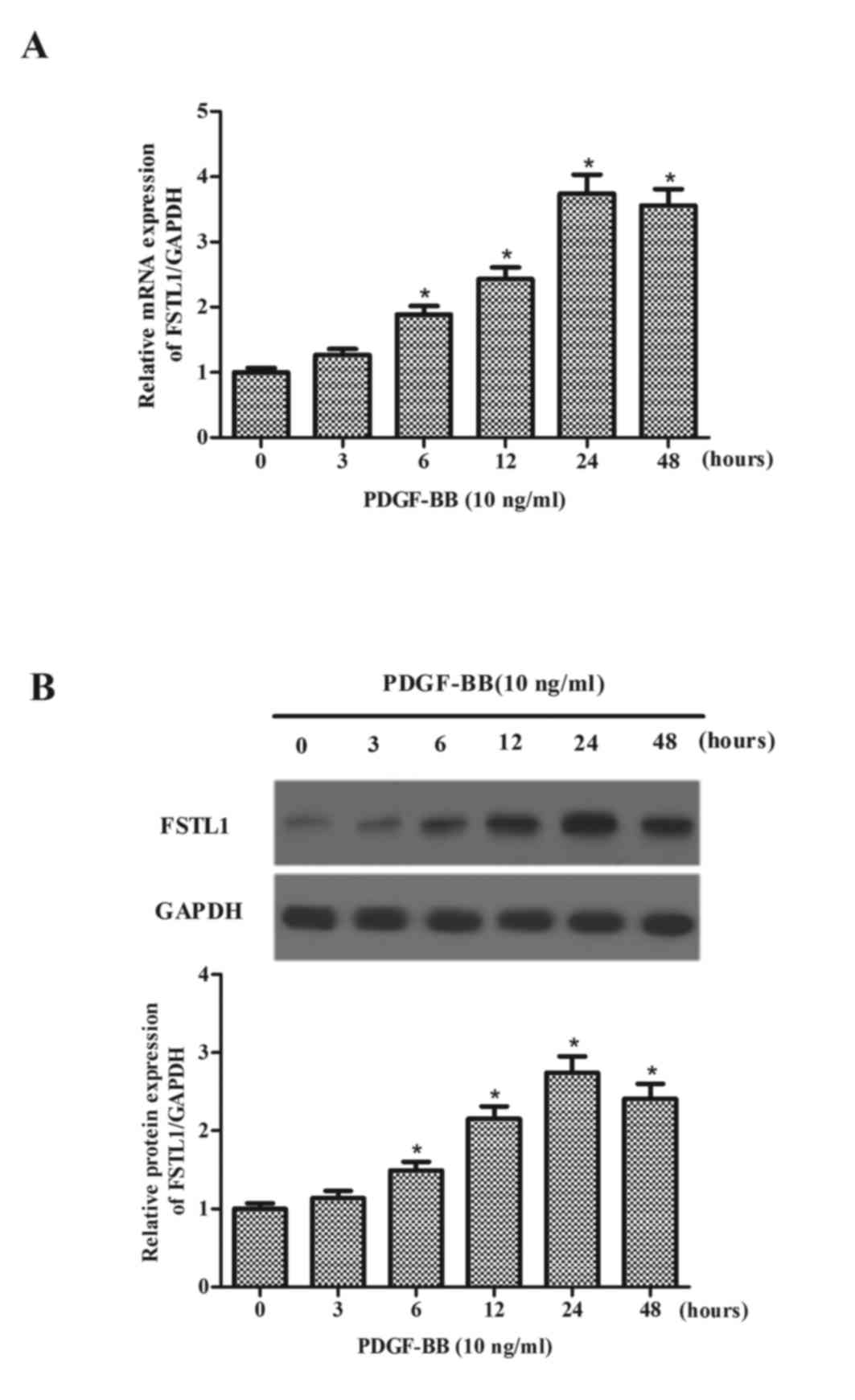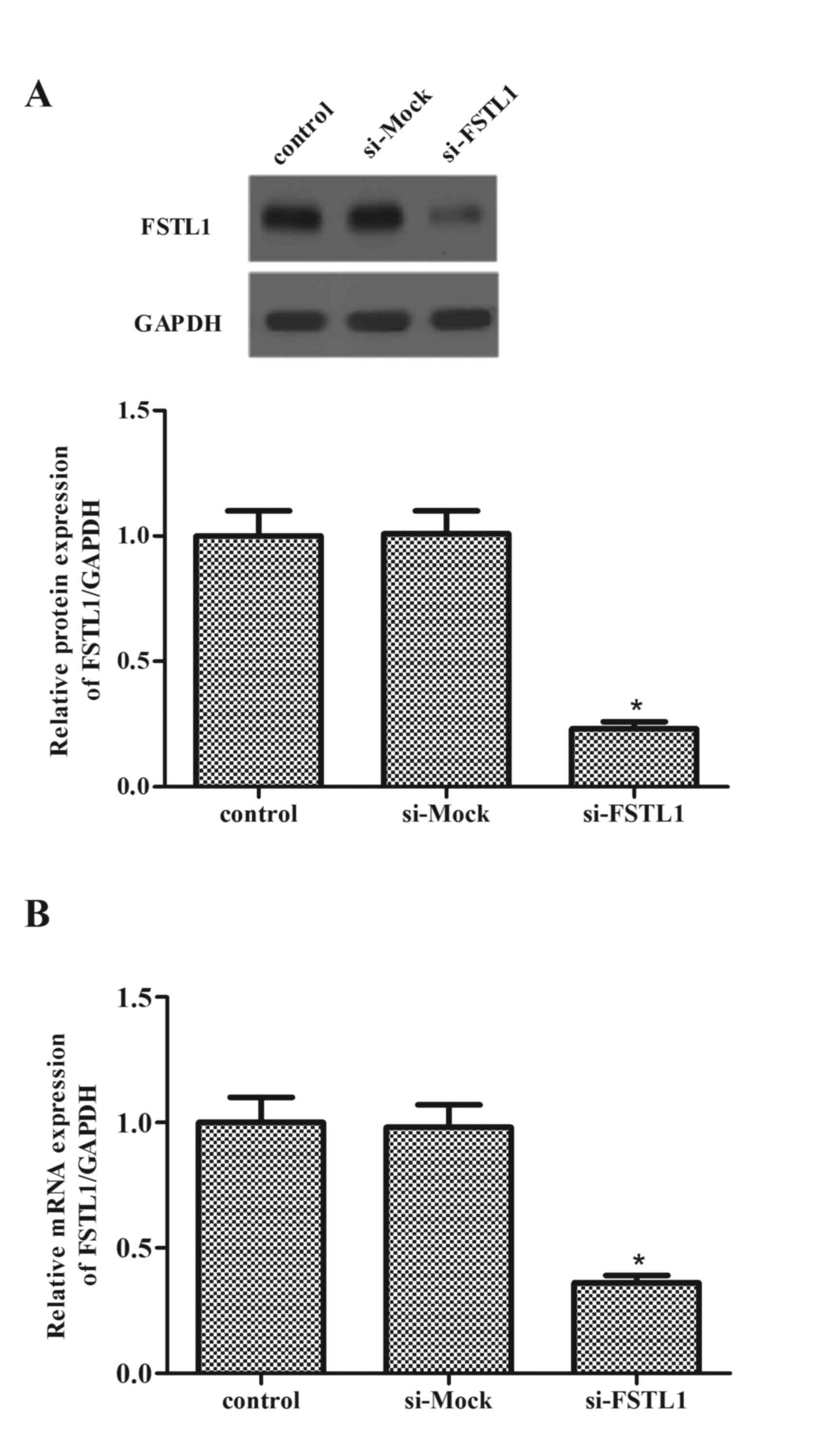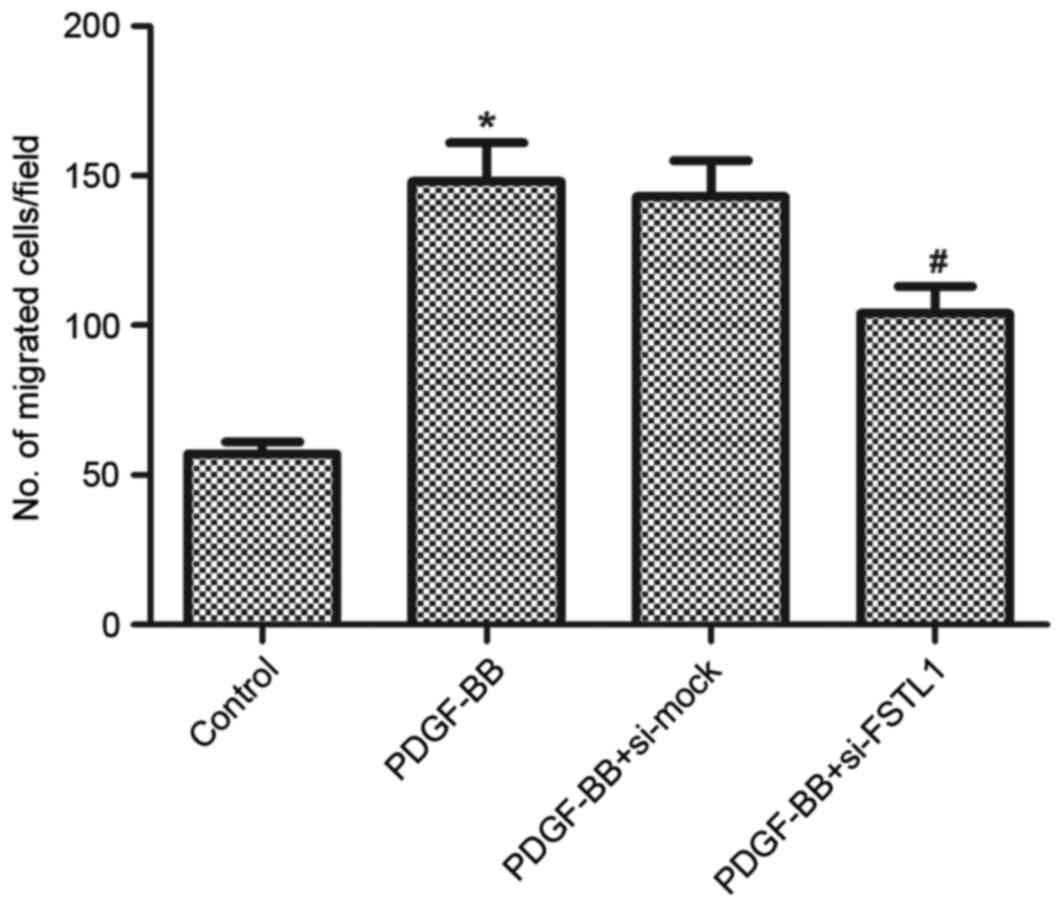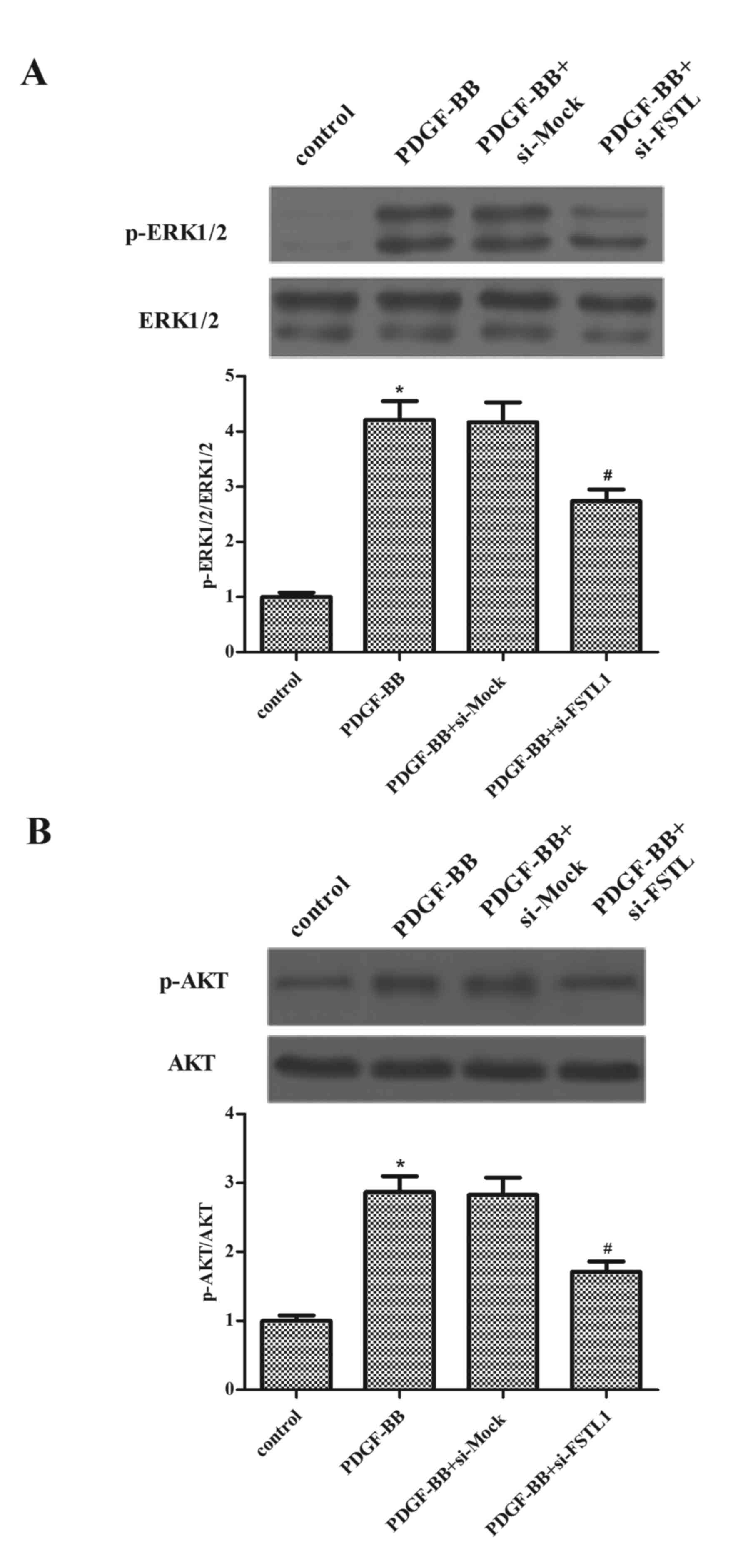Knockdown of FSTL1 inhibits PDGF‑BB‑induced human airway smooth muscle cell proliferation and migration
- Authors:
- Published online on: April 7, 2017 https://doi.org/10.3892/mmr.2017.6439
- Pages: 3859-3864
Abstract
Introduction
Childhood asthma is a group of multifactorial diseases with similar features, including mast cell and eosinophil infiltration, causing airway hyper-responsiveness, inflammation and airway obstruction (1). The prevalence of childhood asthma is increasing worldwide (2,3). Airway smooth muscle (ASM) serves an important role in the various biological processes that are essential for the development of childhood asthma. Increased ASM mass is associated with increased asthma severity (4,5). Additionally, studies have indicated that ASM cell migration towards the airway epithelium, in response to inflammatory mediators including platelet-derived growth factor (PDGF), contributes to airway remodeling (6–8). Therefore, targeting ASM cells may be useful in treating childhood asthma.
Follistatin-like protein 1 (FSTL1), additionally referred to as TSC36, is a secreted glycoprotein that belongs to the follistatin family of proteins. It has been demonstrated to serve important roles in immunomodulation (9), embryonic development (10) and vascularization (11). In addition, FSTL1 maintains the proliferation and survival of tumor cells, and overexpression of FSTL1 significantly suppresses cell proliferation and invasion in ovarian and endometrial cancers (12). Recently, one study revealed that FSTL1 is highly expressed by macrophages in the lungs of patients with severe asthma (13). However, the role of FSTL1 in ASM cell proliferation and migration remains unknown. The present study aimed to investigate the role of FSTL1 in cell proliferation and migration mediated by PDGF subunit B (PDGF-BB) (6), a strong chemoattractant, in human ASM cells. It was demonstrated that knockdown of FSTL1 inhibited PDGF-BB-induced ASM cell proliferation and migration.
Materials and methods
Cell culture
The bronchial-tracheal-derived human ASMC cell line was purchased from the American Type Culture Collection (Manassas, VA, USA) and incubated in Dulbecco's Modified Eagle's medium (DMEM; Gibco; Thermo Fisher Scientific, Inc.) in a humidified atmosphere containing 5% CO2 at 37°C. ASM cells at passage 9 to 20 were used.
FSTL1 suppression by small interfering RNA (siRNA)
For siRNA transfection, 1×105 cells were seeded in 6-cm dishes for 24 h in DMEM medium (Gibco; Thermo Fisher Scientific, Inc.). The cells (1×105 cells/well) were subsequently transfected with 1 µl (10 nM) FSTL1 siRNA (5′-UGCAAAUACUUACGGACUUUU-3′) or non-targeting siRNA (5′-UCUCCGAACGUGUCACGUTT-3′) (Shanghai Sangong Pharmaceutical Co., Ltd., Shanghai, China) for 18 h using Lipofectamine® 2000 reagent (Invitrogen; Thermo Fisher Scientific, Inc., Waltham, MA, USA). Protein silencing was confirmed by western blot analysis. ASM cells were subsequently stimulated with 10 ng/ml PDGF-BB (Sigma-Aldrich; Merck KGaA, Darmstadt, Germany) for 24 h.
Cell proliferation assay
Cell proliferation was evaluated using an MTT assay. Cells were suspended at 1×104 cells/well and 200 µl of this suspension was plated into each well of a 96-well plate. The ASMC cells were cultured with DMEM and cells were growth-arrested prior to every experiment. They were pre-treated with FSTL1 siRNA for 24 h, followed by PDGF-BB stimulation. Following this, the medium was removed, and 20 µl 5 mg/ml MTT in DMEMwas added. The cells were further incubated in 5% CO2 at 37°C for 4 h. Formazan was solubilized with 100 µl dimethyl sulfoxide for 10 min. The absorbance of the solution was measured at a wavelength of 570 nm using a microplate reader (Spectra Max 190; Molecular Devices, LLC, Sunnyvale, CA, USA).
Cell cycle assay
The growth-arrested cells were pre-treated with FSTL1 siRNA for 24 h, followed by PDGF-BB stimulation. The cells were harvested and fixed with ice-cold 70% (v/v) ethanol for 24 h. Following centrifugation at 2,000 × g for 10 min at 37°C, the cell pellet was washed with PBS and resuspended in PBS containing 50 µg/ml propidium iodide, 0.1% (v/v) Triton X-100 and 1 µg/ml DNase-free RNase. The cells were subsequently incubated for 1 h in the dark at room temperature. A flow cytometer (FC 500; Beckman Coulter, Inc., Brea, CA, USA) was used to elucidate cell cycle progression, and this was analyzed using Modfit software (version 3.2; Verity Software House, Topsham, ME, USA).
Cell migration assay
ASM cell migration was measured using a Transwell migration assay. ASM cells at a concentration of 5×104 cells/well, transfected with FSTL1 siRNA, were resuspended gently in DMEM/F-12 medium containing 2% fetal bovine serum (FBS; Invitrogen; Thermo Fisher Scientific, Inc.) and added to into the upper chamber. Following this, 600 µl DMEM/F-12 medium containing 10% FBS with or without PDGF-BB was added into the lower chamber. Following incubation at 37°C for 24 h, the cells on the upper membrane surface were removed by washing with PBS, and those that had migrated to the bottom side of the filter were fixed in methanol and stained with Harris hematoxylin solution for 5 min. The mean number of migrated cells from five randomly selected optical fields under a light microscope (magnification, ×100; Olympus Corporation, Tokyo, Japan) was determined.
Reverse transcription-quantitative polymerase chain reaction (RT-qPCR)
Total RNA was extracted from ASM cells using TRIzol® reagent (Invitrogen; Thermo Fisher Scientific, Inc.) according to the manufacturer's protocol. For mRNA detection, cDNA was generated using Moloney Murine Leukemia Virus Reverse Transcriptase (Clontech Laboratories, Inc., Mountainview, CA, USA). The expression levels of gene mRNA transcripts were analyzed using specific primers, SYBR®-Green I reagent (Invitrogen; Thermo Fisher Scientific, Inc.) and the Bio-Rad iQ5 qPCR system (Takara Biotechnology Co., Ltd., Dalian, China), according to the manufacturer's protocol. The specific primers for FSTL1 were as follows: Sense, 5′-CGAGGTGGAGTTGACGAGAAAC-3′ and antisense, 5′-AGGACTGGATCATCATGACGTTCT-3′. GAPDH were 5′-GGCAAATTCAACGGCACAGTC-3′ (sense), 5′-GCTGACAATCTTGAGTGAGTT-3′ (antisense). The PCR procedure was as follows: An initial denaturation step at 94°C for 4 min, followed by 40 cycles of denaturation at 94°C for 20 sec, annealing at 55°C for 30 sec and extension at 72°C for 20 sec, and a melting curve from 65 to 95°C. GAPDH served as a control for normalizing the gene expression levels and the results were analyzed using the 2−ΔΔCq method (14). The sequences for GAPDH are as follows: 5′-GGCAAATTCAACGGCACAGTC-3′ (sense) and 5′-GCTGACAATCTTGAGTGAGTT-3′ (antisense).
Western blot analysis
Cells were lysed using RIPA Cell lysis buffer (Takara Biotechnology, Co., Ltd., Dalian, China) and protein concentrations were determined using the Bicinchoninic Acid assay kit (Pierce; Thermo Fisher Scientific, Inc.). Equal amounts of protein (30 µg) were separated by 10% SDS-PAGE and transferred onto polyvinylidene difluoride membranes (Whatman; GE Healthcare Life Sciences, Chalfont, UK). The membranes were blocked in 5% nonfat milk in TBS with Tween-20 (TBST; 5 mM Tris-HCl at pH 7.4, 136 mM NaCl, 0.1% Tween-20) for 1 h at room temperature prior to hybridization with the following primary antibodies overnight at 4°C. Detection of rabbit anti-FSTL1 (dilution, 1:1,500; Abcam, Cambridge, UK; cat. no. 111969), mouse anti-phospho-extracellular signal-regulated kinase (ERK; dilution, 1:2,000; Santa Cruz Biotechnology, Inc., Dallas, TX, USA; cat. no. sc-81492), rabbit anti-ERK (dilution, 1:2,000; Santa Cruz Biotechnology, Inc.; cat. no. sc-292838), mouse anti-AKT (dilution, 1:2,000; Santa Cruz Biotechnology, Inc.; sc-5298), rabbit anti-phospho-AKT (dilution, 1:2,000; Santa Cruz Biotechnology, Inc.; cat. no. sc-135650) was performed. The membranes were subsequently washed three times for 5 min with TBST and incubated with bovine anti-rabbit horseradish peroxidase-conjugated secondary antibodies (dilution, 1:3,000; cat. no. sc-2385) for 1 h at room temperature. The resulting protein bands were visualized using an Enhanced Chemiluminescence reagent according to the manufacturer's protocol. The relative expression levels of each protein compared with GAPDH were analyzed. BandScan software (version 5.0; Glyko, Novato, CA, USA) was used for the quantification of all proteins following western blot analysis.
Statistical analysis
All experiments were performed in at least triplicate and results are expressed as the mean ± standard deviation. Statistical comparisons were performed using one-way analysis of variance followed by the Student's t-test. P<0.05 was considered to indicate a statistically significant difference.
Results
FSTL1 is upregulated in PDGF-BB-treated ASM cells
The present study initially measured the expression levels of FSTL1 in PDGF-BB-treated ASM cells. As presented in Fig. 1A, after 6 h PDGF-BB markedly increased the mRNA expression levels of FSTL1, reaching a peak at 24 h. Additionally, the expression levels of the FSTL1 protein were increased by PDGF-BB (Fig. 1B) in a time-dependent manner.
Knockdown of FSTL1 expression levels in ASM cells
Following this, ASM cells were transfected with FSTL1 siRNA, and the efficiency of transfection was evaluated by western blot and RT-qPCR analysis. Western blot data revealed that transfection of FSTL1 siRNA markedly decreased the expression levels of FSTL1 protein (P=0.016; Fig. 2A). Consistent with the results of western blot, western blot analysis demonstrated that FSTL1 siRNA inhibited the mRNA expression levels of FSTL1 (P=0.029; Fig. 2B).
Knockdown of FSTL1 inhibits PDGF-BB-induced ASM cell proliferation
The role of FSTL1 in PDGF-BB-stimulated proliferation of ASM cells was subsequently investigated. As presented in Fig. 3A, compared with the control group, PDGF-BB treatment markedly increased cell proliferation (P=0.034; P=0.026). However, knockdown of FSTL1 significantly inhibited PDGF-BB-induced ASM cell proliferation (P=0.043; P=0.036).
To further examine the effect of FSTL1 on PDGF-BB-induced ASM cell proliferation, cell cycle progression was evaluated by flow cytometry. As presented in Fig. 3B, PDGF-BB induced the entry of ASM cells to the synthesis phase (S-phase) to undergo proliferation, with 62.5±1.6% cells in G0/G1 phase (compared with 73.1±2.5% in the control; P=0.041) and 31.2±1.9% in S-phase (compared with 19.4±1.3% in the control; P=0.031), whereas the knockdown of FSTL1 significantly arrested the cell cycle at the G2/M phase (18.6±1.7 vs. 5.8±1.1% in the PDGF-BB group; P=0.028).
Knockdown of FSTL1 inhibits PDGF-BB-induced ASM cell migration
Following this, the effect of FSTL1 on ASM cell migration induced by PDGF-BB was examined using a Transwell migration assay. As presented in Fig. 4, PDGF-BB resulted in a 2.59-fold increase in the number of cells that migrated through the membrane compared with the untreated control (P=0.023), whereas knockdown of FSTL1 markedly inhibited PDGF-BB-induced ASM cell migration (P=0.036).
Knockdown of FSTL1 inhibits PDGF-BB-induced activation of ERK and AKT in ASM cells
To investigate the underlying mechanisms by which FSTL1 affected PDGF-BB-induced ASM cell proliferation and migration, the effect of FSTL1 on the activation of ERK and AKT in PDGF-BB-stimulated ASM cells was examined. As presented in Fig. 5, the protein expressions levels of p-ERK1/2 and p-AKT increased following PDGF-BB stimulation, whereas the knockdown of FSTL1 markedly inhibited PDGF-induced expression levels of p-ERK1/2 and p-AKT.
Discussion
Abnormal proliferation and migration of ASM cells serve roles in airway remodeling and contribute to airway hyper-responsiveness. The present study demonstrated that PDGF-BB stimulation upregulated FSTL1 expression levels in ASM cells in vitro. Knockdown of FSTL1 inhibited cell proliferation and arrested the cell cycle in the G2/M phase in PDGF-BB-stimulated ASM cells. Additionally, FSTL1 knockdown inhibited PDGF-BB-induced ASM cell migration. Furthermore, knockdown of FSTL1 caused downregulation of p-ERK and p-AKT protein expression levels induced by PDGF-BB in ASM cells.
A previous study reported that FSTL1 acted as a bone morphogenetic protein 4 antagonist during lung development (15). FSTL1 expression is induced in response to lung injury and mediates the accumulation of myofibroblasts and subsequent fibrosis; inhibition of FSTL1 with a neutralizing antibody in mice reduced bleomycin-induced fibrosis in vivo (16). The present study demonstrated that PDGF-BB stimulation upregulated FSTL1 expression levels in ASM cells in vitro. These data suggested that FSTL1 may serve a critical role in in asthmatic ASM remodeling.
FSTL1 has been reported to inhibit proliferation and invasion, and to induce apoptosis of cancer cells in vitro (17,18). In addition, increasing evidence indicates that PDGF is involved in the pathophysiology of asthma, and that PDGF is a potent mitogen that may mediate ASM cell proliferation and migration (19–21). The present study revealed that knockdown of FSTL1 inhibited cell proliferation and arrested the cell cycle in the G2/M phase in PDGF-BB-stimulated ASM cells. In addition, it was observed that the knockdown of FSTL1 inhibited PDGF-BB-induced ASM cell migration.
It has been reported that the dual phosphoinositide 3-kinase (PI3K)/AKT and ERK pathways may regulate ASM cell proliferation and migration (22–24). AKT is a primary downstream target of PI3K, activated in response to various stimuli, growth factors and hormones. ERK1/2 belongs to the mitogen-activated protein kinase family and is located downstream of the Raf/Ras/mitogen-activated protein kinase kinase cascade. A previous study demonstrated that ERK and AKT activation was significantly greater in ASM cells from asthmatic, compared with non-asthmatic, subjects (25), and that the inhibition of the ERK1/2 or PI3K/AKT signaling pathway significantly inhibited ASM proliferation (26). Additionally, one study reported that the overexpression of FSTL1 protected cultured neonatal rat ventricular myocytes from hypoxia/reoxygenation-induced apoptosis, and that this protective effect was dependent on the upregulation of AKT and ERK activities. The knockdown of FSTL1 in cardiac myocytes decreased basal AKT signaling and increased cell apoptosis (27). The present study revealed that PDGF-BB-induced ASM cell migration was partially mediated by inhibition of the activation of ERK and AKT. These data are consistent with those of previous studies in which the activation of ERK and AKT were demonstrated to mediate ASM proliferation and migration induced by various growth factors, including PDGF-BB (20,28,29). Furthermore, the present study revealed that the knockdown of FSTL1 markedly inhibited PDGF-BB-induced protein expression levels of p-ERK and p-AKT.
In conclusion, the results of the present study demonstrated that knockdown of FSTL1 inhibited ASM cell proliferation and migration induced by PDGF-BB at least partially via inhibiting the activation of ERK and AKT. These results provide novel insight into the pathogenesis of airway remodeling in childhood asthma and FSTL1 may be a possible therapeutic strategy for the treatment of asthma.
References
|
Noutsios GT and Floros J: Childhood asthma: Causes, risks, and protective factors; a role of innate immunity. Swiss Med Wkly. 144:w140362014.PubMed/NCBI | |
|
Asher MI, Montefort S, Björkstén B, Lai CK, Strachan DP, Weiland SK and Williams H; ISAAC Phase Three Study Group, : Worldwide time trends in the prevalence of symptoms of asthma, allergic rhinoconjunctivitis, and eczema in childhood: ISAAC Phases One and Three repeat multicountry cross-sectional surveys. Lancet. 368:733–743. 2006. View Article : Google Scholar : PubMed/NCBI | |
|
De Marco R, Cappa V, Accordini S, Rava M, Antonicelli L, Bortolami O, Braggion M, Bugiani M, Casali L, Cazzoletti L, et al: Trends in the prevalence of asthma and allergic rhinitis in Italy between 1991 and 2010. Eur Respir J. 39:883–892. 2012. View Article : Google Scholar : PubMed/NCBI | |
|
Zuyderduyn S, Sukkar M, Fust A, Dhaliwal S and Burgess JK: Treating asthma means treating airway smooth muscle cells. Eur Respir J. 32:265–274. 2008. View Article : Google Scholar : PubMed/NCBI | |
|
Hirst SJ, Martin JG, Bonacci JV, Chan V, Fixman ED, Hamid QA, Herszberg B, Lavoie JP, McVicker CG, Moir LM, et al: Proliferative aspects of airway smooth muscle. J Allergy Clin Immunol. 114(2 Suppl): S2–S17. 2004. View Article : Google Scholar : PubMed/NCBI | |
|
Carlin SM, Roth M and Black JL: Urokinase potentiates PDGF-induced chemotaxis of human airway smooth muscle cells. Am J Physiol Lung Cell Mol Physiol. 284:L1020–L1026. 2003. View Article : Google Scholar : PubMed/NCBI | |
|
Madison JM: Migration of airway smooth muscle cells. Am J Respir Cell Mol Biol. 29:8–11. 2003. View Article : Google Scholar : PubMed/NCBI | |
|
Parameswaran K, Radford K, Zuo J, Janssen L, O'byrne P and Cox P: Extracellular matrix regulates human airway smooth muscle cell migration. Eur Respir J. 24:545–551. 2004. View Article : Google Scholar : PubMed/NCBI | |
|
Le Luduec JB, Condamine T, Louvet C, Thebault P, Heslan JM, Heslan M, Chiffoleau E and Cuturi MC: An immunomodulatory role for follistatin-like 1 in heart allograft transplantation. Am J Transplant. 8:2297–2306. 2008. View Article : Google Scholar : PubMed/NCBI | |
|
Esterberg R, Delalande JM and Fritz A: Tailbud-derived Bmp4 drives proliferation and inhibits maturation of zebrafish chordamesoderm. Development. 135:3891–3901. 2008. View Article : Google Scholar : PubMed/NCBI | |
|
Ouchi N, Oshima Y, Ohashi K, Higuchi A, Ikegami C, Izumiya Y and Walsh K: Follistatin-like 1, a secreted muscle protein, promotes endothelial cell function and revascularization in ischemic tissue through a nitric-oxide synthase-dependent mechanism. J Biol Chem. 283:32802–32811. 2008. View Article : Google Scholar : PubMed/NCBI | |
|
Chan QK, Ngan HY, Ip PP, Liu VW, Xue WC and Cheung AN: Tumor suppressor effect of follistatin-like 1 in ovarian and endometrial carcinogenesis: A differential expression and functional analysis. Carcinogenesis. 30:114–121. 2009. View Article : Google Scholar : PubMed/NCBI | |
|
Miller M, Beppu A, Rosenthal P, Pham A, Das S, Karta M, Song DJ, Vuong C, Doherty T, Croft M, et al: Fstl1 promotes asthmatic airway remodeling by inducing oncostatin M. J Immunol. 195:3546–3556. 2015. View Article : Google Scholar : PubMed/NCBI | |
|
Livak KJ and Schmittgen TD: Analysis of relative gene expression data using real-time quantitative PCR and the 2(−Delta Delta C(T)) method. Methods. 25:402–408. 2001. View Article : Google Scholar : PubMed/NCBI | |
|
Geng Y, Dong Y, Yu M, Zhang L, Yan X, Sun J, Qiao L, Geng H, Nakajima M, Furuichi T, et al: Follistatin-like 1 (Fstl1) is a bone morphogenetic protein (BMP) 4 signaling antagonist in controlling mouse lung development. Proc Natl Acad Sci USA. 108:pp. 7058–7063. 2011; View Article : Google Scholar : PubMed/NCBI | |
|
Dong Y, Geng Y, Li L, Li X, Yan X, Fang Y, Li X, Dong S, Liu X, Li X, et al: Blocking follistatin-like 1 attenuates bleomycin-induced pulmonary fibrosis in mice. J Exp Med. 212:235–252. 2015. View Article : Google Scholar : PubMed/NCBI | |
|
Johnston I, Spence HJ, Winnie JN, McGarry L, Vass JK, Meagher L, Stapleton G and Ozanne BW: Regulation of a multigenic invasion programme by the transcription factor, AP-1: Re-expression of a down-regulated gene, TSC-36, inhibits invasion. Oncogene. 19:5348–5358. 2000. View Article : Google Scholar : PubMed/NCBI | |
|
Sumitomo K, Kurisaki A, Yamakawa N, Tsuchida K, Shimizu E, Sone S and Sugino H: Expression of a TGF-beta1 inducible gene, TSC-36, causes growth inhibition in human lung cancer cell lines. Cancer Lett. 155:37–46. 2000. View Article : Google Scholar : PubMed/NCBI | |
|
Wei Y, Xu YD, Yin LM, Wang Y, Ran J, Liu Q, Ma ZF, Liu YY and Yang YQ: Recombinant rat CC10 protein inhibits PDGF-induced airway smooth muscle cells proliferation and migration. Biomed Res Int. 2013:6909372013. View Article : Google Scholar : PubMed/NCBI | |
|
Liu W, Kong H, Zeng X, Wang J, Wang Z, Yan X, Wang Y, Xie W and Wang H: Iptakalim inhibits PDGF-BB-induced human airway smooth muscle cells proliferation and migration. Exp Cell Res. 336:204–210. 2015. View Article : Google Scholar : PubMed/NCBI | |
|
Ning Y, Huang H, Dong Y, Sun Q, Zhang W, Xu W and Li Q: 5-Aza-2-deoxycytidine inhibited PDGF-induced rat airway smooth muscle cell phenotypic switching. Arch Toxicol. 87:871–881. 2013. View Article : Google Scholar : PubMed/NCBI | |
|
Day RM, Lee YH, Park AM and Suzuki YJ: Retinoic acid inhibits airway smooth muscle cell migration. Am J Respir Cell Mol Biol. 34:695–703. 2006. View Article : Google Scholar : PubMed/NCBI | |
|
Lee JH, Johnson PR, Roth M, Hunt NH and Black JL: ERK activation and mitogenesis in human airway smooth muscle cells. Am J Physiol Lung Cell Mol Physiol. 280:L1019–L1029. 2001.PubMed/NCBI | |
|
Xie S, Sukkar MB, Issa R, Oltmanns U, Nicholson AG and Chung KF: Regulation of TGF-beta 1-induced connective tissue growth factor expression in airway smooth muscle cells. Am J Physiol Lung Cell Mol Physiol. 288:L68–L76. 2005. View Article : Google Scholar : PubMed/NCBI | |
|
Burgess JK, Lee JH, Ge Q, Ramsay EE, Poniris MH, Parmentier J, Roth M, Johnson PR, Hunt NH, Black JL and Ammit AJ: Dual ERK and phosphatidylinositol 3-kinase pathways control airway smooth muscle proliferation: Differences in asthma. J Cell Physiol. 216:673–679. 2008. View Article : Google Scholar : PubMed/NCBI | |
|
Stewart AG, Xia YC, Harris T, Royce S, Hamilton JA and Schuliga M: Plasminogen-stimulated airway smooth muscle cell proliferation is mediated by urokinase and annexin A2, involving plasmin-activated cell signalling. Br J Pharmacol. 170:1421–1435. 2013. View Article : Google Scholar : PubMed/NCBI | |
|
Oshima Y, Ouchi N, Sato K, Izumiya Y, Pimentel DR and Walsh K: Follistatin-like 1 is an Akt-regulated cardioprotective factor that is secreted by the heart. Circulation. 117:3099–3108. 2008. View Article : Google Scholar : PubMed/NCBI | |
|
Movassagh H, Shan L, Halayko AJ, Roth M, Tamm M, Chakir J and Gounni AS: Neuronal chemorepellent Semaphorin 3E inhibits human airway smooth muscle cell proliferation and migration. J Allergy Clin Immunol. 133:560–567. 2014. View Article : Google Scholar : PubMed/NCBI | |
|
Walker TR, Moore SM, Lawson MF, Panettieri RA Jr and Chilvers ER: Platelet-derived growth factor-BB and thrombin activate phosphoinositide 3-kinase and protein kinase B: Role in mediating airway smooth muscle proliferation. Mol Pharmacol. 54:1007–1015. 1998.PubMed/NCBI |














